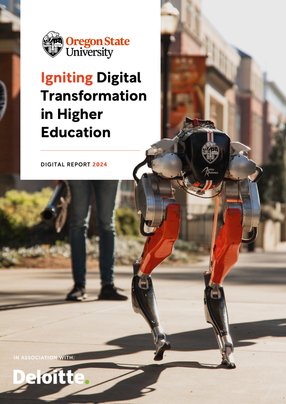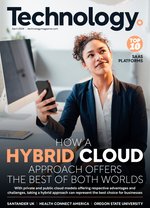OSU: Igniting Digital Transformation in Higher Education
Technology and the digital flow of information are the keystone supports for OSU’s strategic goals and the administration, operation, development and delivery of university services.
In her role as Vice Provost and Chief Information Officer (VP/CIO) for University Information and Technology (UIT) at Oregon State University (OSU), Andrea Ballinger is responsible for providing enterprise IT services and university-wide IT infrastructures. UIT guides policy development and governs IT resources in OSU’s academic, extension, administrative and college research units.
UIT promotes and maintains a trusted, collaborative and community-driven IT environment using governance and advisory groups to advance and support OSU’s mission and values.
Aligning IT strategy with the university’s needs and strategic goals, Ballinger and her team drive innovation and strive for operational excellence to meet the evolving expectations of students, faculty, researchers and employees.
Rising to become a leader in technology and higher education was a journey far from what Ballinger ever imagined. As she puts it: “I had absolutely no intention of being in higher ed when I was younger, or even technology for that matter. I wanted to be a pediatrician!”
With her natural strengths in math and science, becoming a pediatrician was Ballinger’s way of combatting the misogynist expectations for a contemporary woman’s career.
She continues: “People always used to tell me becoming a pediatrician is not something women do; ‘women should be nurses’, they used to say. I was determined to dispel that stereotype.”
Early career planning doesn’t always pan out as anticipated. When Ballinger realised the work of a pediatrician wouldn’t allow her the level of control she wanted in her working life, she embraced finance and later information and technology.
She explains: “Going to college, I ended up having a finance degree, and later on I completed my MBA. My first job in banking was in the 1980s and 1990s, which, at the time, was all about mergers and acquisitions.
“What made the difference between the top financial organisations and the rest was the technology. Those that led had really strong technology at the core of what they were doing, and good data too.”
When giving a presentation on solving the Year 2000 Problem (Y2K), Ballinger had her first interaction with higher ed when the University of Illinois recognised the need for her expertise.
“I enjoy working in high-speed environments and, in my mind, higher ed did not meet this criteria,” says Ballinger. “I thought by working in higher ed I would get bored easily, but I realised that overseeing a university is more like overseeing a city, with different businesses inside it, I was in.”
Ballinger: The technology leader with a vast area of interest
One could be forgiven for thinking Ballinger’s role extends only as far as IT in support of the administration and instruction of an educational institution, but this couldn’t be further from the truth. As she tells us, the internal businesses of a university extend much further.
“At OSU, we provide the technology for our police department, a student health organisation, a veterinary medical hospital, our internal public works department that supports a community of more than 20,000 people, advanced research programmes – including research ships – and internal banking services – and we have to bring that all together across our IT services and infrastructure,” Ballinger notes.
“Not only do we have internal technological responsibilities, but as a land-grant institution, we are charged by the state to promote the health of communities in all 36 counties in Oregon.
“When you have a presence with that much reach, the problems you have to solve are not just localised to OSU, but issues the world is trying to solve.”
Of course, to meet the scale her role demands, Ballinger must oversee not just one, but multiple teams that work in conjunction with a full enterprise architecture in separate domains.
Adhering to the TOGAF framework, Ballinger and her team effectively move from identifying problems as opportunities and providing solutions that meet the demands of the day.
And it is exactly this – honouring the responsibilities that come with being CIO at OSU – that for Ballinger and her team is one of the biggest challenges.
As she puts it: “Being CIO of a large organisation is not for the faint of heart. As an IT leader, I have to understand the complexities of the business and be an advocate and a good steward of the resources allocated to me.
“Not only do I have to consider the expectations OSU has for a particular resource, but I need to use my experience and know-how to improve efficacy. I don’t just want to be the best of a few, I want us to be the best of the best.
“I want us to push the limits of technology, of innovation and creative thinking. I want us to arrive at a place where we are as inclusive as we can be and as personalised as we can be when it comes to the student, faculty and community experience.”
OSU and the path to digital enablement
Since Ballinger arrived at OSU four years ago, she has been driving the organisation on its path to transformation.
“There are institutions at various places on the path to transformation,” she says, “some that just want to maintain their situation and others want and can make transformative change.”
“I would not have joined OSU if it wasn’t an institution committed to evolving, and providing an experience for the students and faculty that matters and is up to speed with what today’s culture requests of us.”
Ballinger now leads an innovative five-part strategic plan at OSU, with each segment building on one another to scale technological capabilities in support of the university’s mission—teaching, learning, research, outreach and engagement.
“The great thing is nothing was fundamentally broken when I joined,” she notes, “and the leadership at OSU wanted to aggressively move forward with OSU’s technological capabilities.”
Like many institutions, OSU had added technological upgrades to what was still a 1950s-based infrastructure before undertaking its digital enablement transformation.
“Having old infrastructure was fine,” adds Ballinger, “as we could still operate. But the question was around sustainability – were we operating as efficiently as we could? We could do better and still can.
“Our transformation plan was put in place to overcome technical burdens and drastically reduce technical debt so that we could continue to be relevant and keep up with the modern expectations of our students, faculty and the wider community.
“There were components of OSU services that were best in class, such as our online educational programmes. But in terms of our business processes, there were instances where students still needed to complete things on paper because they weren’t digitised.
“When I joined, the first thing I did was to fully engage the entire OSU IT team to be fully aligned and on board with the transformation initiatives we were going to put in place. It’s so important to start with a deliberate and shared vision as the core of the digital enablement process.”
Getting everyone aligned with a singular vision may sound easier than it is in practice, particularly at higher ed institutions like OSU where not everybody dealing in IT has the same reporting line.
“I spent a lot of time in my first 100 days just getting to know people,” adds Ballinger, “understanding how different segments of this large city-like organisation fed into one another. That was crucial to establishing our shared vision – stage one of our process.”
But, of course, shared visions remain just that unless a clear path can be created to reach your established aims. To move to the next phase on the path to digital enablement, Ballinger and the team began defining those paths.
She continues: “We set about getting central, enterprise IT services and distributed IT services to participate together in all of the efforts we were working on. This included collaborating on Microsoft Teams to refine our roadmap, improve transparency of operations, increase operational efficiency and see how we could operate as a unified OSU IT Team, regardless of day-to-day reporting lines.”
However, once dialogue between OSU’s IT departments was established and the path to transformation was clear, Ballinger soon realised that the OSU team didn’t have all of the modern skills at its disposal to enact the required change.
“This is when we set about creating capacity,” Ballinger outlines. “So, we were looking at some processes that could perhaps be stopped – manual, laborious tasks that weren’t adding value that could be put aside so we could create capacity to level up skills.
“For two years we enacted some intensive training, and we established Get Stuff Done Teams –highly agile teams put in place to scale our skills while increasing capacity to get to a point where we could deliver digital transformation.
“With 17 diverse GSD teams working on different priorities, we’ve seen true foundational change, with upgrades and total redesign to lay the groundwork for what we’re building on right now.
“Every one of our GSD teams had representation from not only the enterprise IT functions that directly report to me, but all of our distributed IT personnel, and with effective communication we were able to push things through and get the funding needed to make transformative change.
“Within that I created many paths, such as Strategic Mentoring for Managers, which encompassed 12 months of one-on-one classes where I helped train individuals on what it is to be a leader IT and helped them to identify their own needs.
“Now, we have leaders in IT who have asked themselves: ‘Do I still want to be a team lead? Do I still want to be a manager or a director?’ IT leaders become leaders because they’re great at using the latest technology, and now we have scaled our staff skills to deliver great leaders.”
“The additional work we’ve done in IT has helped us grow our own identity. IT now has a presence in every system at OSU.
“This has helped OSU not only stand up as a STEM institution but helped take us further by integrating all departments through IT, so we can scale and level up effectively as one.”
Ballinger discusses OSU’s role as a STEM Institution
Here, Andrea Ballinger, Vice Provost and CIO at OSU discusses the higher ed organisation’s role as a Science, Technology, Engineering and Mathematics (STEM) institution.
OSU is one of three land, sea, space and sun grant universities in the US. Each grant has a unique focus, but a common thread integrates them into the university’s teaching, research and extension missions.
The university’s strategic objective is to advance as a world leader in solutions-focused transdisciplinary research that enhances the well-being of people, communities and the natural environment.
“STEM fields have been and will continue to be part of OSU’s DNA. Our robotics, artificial intelligence and new technologies in agriculture highlight our commitment to being a STEM organisation.
“STEM is central to OSU’s strategic plan, Prosperity Widely Shared. We are doubling research revenue and aiming for continued enrollment growth – many of these students will be STEM students.
“We like to think we go beyond just traditional STEM students. OSU is deeply committed to equity, diversity, inclusion and accessibility, and encourages and supports the success of non-traditional students in STEM programmes.
OSU’s College of Engineering (COE) has been recognised nationally for diversity due to its drive to employ diverse faculty and research staff. COE is also home to the Center for Diversity and Inclusion, which is committed to increasing the number of underrepresented students pursuing and completing degrees in engineering.
Many student organisations devoted to women and underrepresented communities in science and engineering have an active presence on the Oregon State University campuses. Women in Science and Engineering (WISE) offers an opportunity for women in STEM fields to gain coaching and mentorship specific to their programme and reside in a community with their peers.
“Diversity in leadership and perspectives is fundamental to success and OSU has actively advanced efforts to provide equitable opportunities and paths for underrepresented communities in STEM.
“In OSU IT, we are deeply committed to diversity, equity, inclusion and accessibility as an active practice in alignment with the institution. One of the current areas I am focusing on is advancing women in IT.
“This is a very personal and worthwhile effort. The OSU Women in IT initiative is a crucial first step in our broader effort to address the underrepresentation of all groups and create future IT leaders. We aim to set an example and pave the way for greater diversity and equity across all groups in IT.
“Women leaders in OSU IT are proactively engaged and participate at the local and national level to develop a pipeline for women’s leadership in IT and higher education. I cannot wait to see what this new level of diversity in our teams will yield in a very short time.”
Continuing the path to digital enablement today
Ballinger has established a clear vision, unified OSU’s IT Teams and increased capacity to upskill her teams’ technological abilities, the next step (phase four) – for now, and the future – is igniting transformative change with urgency and imagination across the organisation.
Ballinger and her teams are well on their way to enabling a digital future at OSU.
“We’re close to finalising what we initially set out to accomplish,” she says. “First, it was to streamline and simplify our IT approach – removing duplicate processes from within the organisation, which we’re close to completing.
“Second was freeing data, which included creating a new data platform and ecosystem to deliver data as a strategic asset. Securely and based on role.
“When I joined the organisation, we had no confidence in our identity platform, but now we have that in a zero-trust strategy.
“Third, create agility in the institution by redesigning business processes, using technology to resolve points of friction and solve specific problems.”
One such problem Ballinger and her teams have corrected is the onboarding of new faculty.
“It used to take 20 people and 35 days to onboard new faculty members,” she explains.
“The process was digitised but still in paper form, so it essentially just mimicked the process of traditional paperwork. Now with the full partnership of our Chief HR Officer, we have solved and streamlined that process.”
However, there is still much more Ballinger is looking forward to achieving on the path to transformation at OSU. The first is seeing through a new administrative modernisation programme.
“The Administrative Modernisation Programme (AMP), will replace our existing ERP, which is 34 years old now, and augment it with new applications so we can stay up-to-date and deliver a modern ERP solution,” she reveals. "This is going to kick off in June 2024. “Next, we’re looking to double the amount of research expenditures in six years. The plan is for this to be complete by 2030, so we’ll be rapidly deepening IT support for our researchers and their collaborators.”
OSU and the value of partnerships
OSU’s digital enablement efforts would not have been possible without the valuable support of strategic partners, and Ballinger is glad to count Deloitte, Workday, NVIDIA and Microsoft among those.
“We’re very excited to have received a significant gift from Jen-Hsun and Lori Huang at NVIDIA to bring a SuperPOD to campus,” she says. “The SuperPOD will give us GPU capacity to the nth degree and will be one of the most powerful university AI supercomputers upon its release.
“The technology we will receive isn’t even in use today. The systems are still being designed for use two years from now, so I’m very excited to see what we’ll be able to achieve with it.”
What’s more, Ballinger can credit the efficiency of OSU’s enterprise architecture to its partnership with Microsoft – indeed, she calls the relationship “priceless”.
She adds: “With Microsoft, there is a group of people we have face-to-face partnerships with. They share their view of things from the private sector, which is particularly valuable as Microsoft’s reach extends across multiple industries.
“We understand where higher ed is in the wider picture of technology, and what we need to do to catch up to other industries across the globe.
“The AMP is why we’re bringing in Deloitte. They’ll be able to help us prepare people to use and adopt these technologies in the right way, leverage secure and quality data and be more productive while doing their jobs. They understand that our digital transformation has humans at the centre of it and its success needs to be measured from that perspective.”
“Deloitte is bringing in a Change Management framework for us to create muscle and exercise that muscle – with our AMP as the catalyst.”
Igniting digital transformation with OSU
With these partnerships and OSU’s path to continued digital enablement in place, Ballinger is confident that she and her IT teams can “ignite digital transformation with creativity and a sense of urgency”.
“It really is now or never. We’ve put all the processes in place and now it’s time for us to act,” Ballinger concludes.
“We have been deliberating, planning and preparing – creating the capacity and capabilities to achieve lasting transformation. Now it is time for us to deliver on our vision for a modern brick-and-pixel future.
“I truly believe now is the most exciting time to be a CIO in higher ed. And, for us at OSU, the next 36 months will show that we put in the work and are ready to accomplish our goals with our AMP and reimagined research capabilities.
“I’ve always been a dreamer who never gets bored and is never satisfied with the status quo.
“I’m more motivated than ever to deliver on simplifying IT, create a contemporary experience for faculty, staff and students, and elevate the OSU experience – a digital enablement process that extends our digital footprint for the betterment of all 36 counties in Oregon and beyond.”
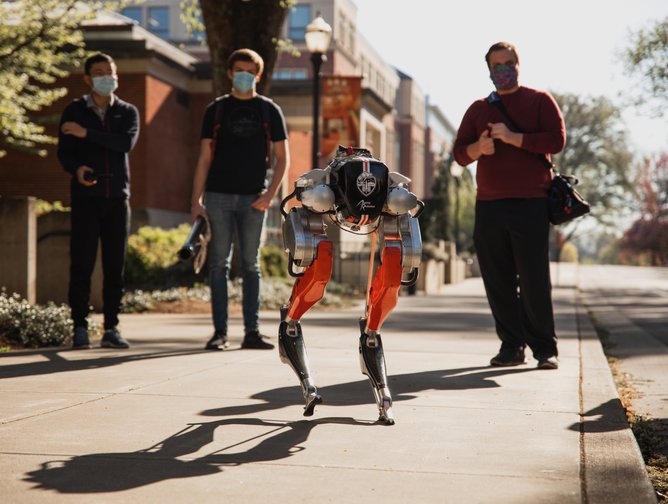

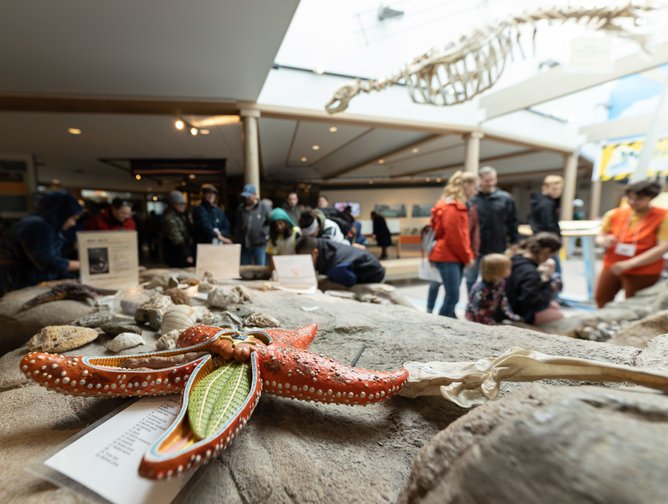
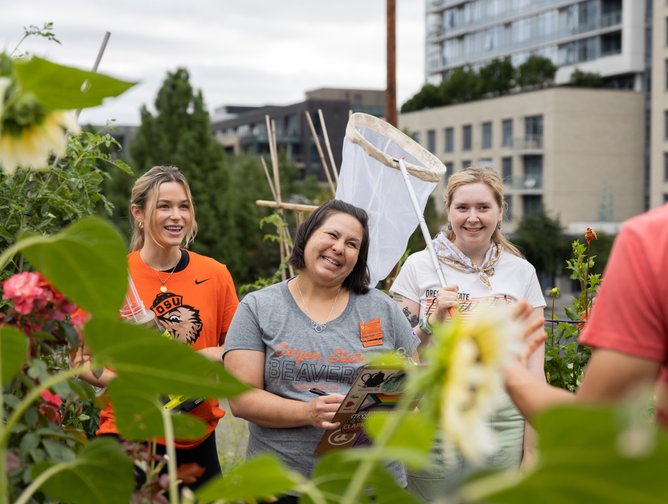
******
Make sure you check out the latest edition of Technology Magazine and also sign up to our global conference series - Tech & AI LIVE 2024
******
Technology Magazine is a BizClik brand
- Top 100 Women 2024: Tanja Rueckert, Bosch - No. 6Digital Transformation
- Deloitte: Delivering Cloud ERP for Higher EducationCloud & Cybersecurity
- Deloitte: Delivering Cloud ERP for Higher EducationCloud & Cybersecurity
- Coforge: Arming Financial Firms with the Tools to InnovateDigital Transformation

